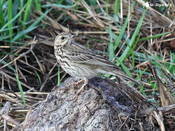search
Мастера на PROFI.RU:
| Ремонт квартир |
| Уборка квартир |
| Мастера по маникюру |
classification:
Gaviiformes
Podicipediformes
Pelecaniformes
Ciconiiformes
Phoenicopteriformes
Anseriformes
Falconiformes
Galliformes
Gruiformes
Charadriiformes
Pterocletiformes
Columbiformes
Cuculiformes
Strigiformes
Caprimulgiformes
Apodiformes
Coraciiformes
Upupiformes
Piciformes
Passeriformes
|
basic information
|
Tree Pipit
Anthus trivialis (Linnaeus, 1758)

|
 adult
|
|
|
2015-04-20
VKO, Ust-Kamenogorsk |
© Viktor Kolesnikov
|
|
Description
The Tree Pipit is slightly less than Sparrow. Upperparts are olive-grey often buffy tinged; underparts are pale-buffy. The rump is plain olive-grey, may be with slightly buffy tinge without or with barely appreciable streaks. The breast is with bold neat streaks well differed from the fine flanks streaks. The short dark lores continues from eye to bill. The light strip continued from bill on cheek below is buffy. Some specimens have quite contrast head pattern including pale and dark spots over ear as on Olive-backed Pipit; but never in combination with pale supercilium. It is distinguished from the Olive-backed Pipit by the more buffy tinge of plumage, slightly appreciable pale supercilium, lack of apparent olive-green color on mantle. From the Meadow Pipit it is distinguished by the more buffy color; more stocky constitution; curved and short (shorter than toe) claw of rear toe; more stout bill; more plain mantle. Both sexes are similar. The autumn plumage is more buffy than spring one; especially on juveniles also having the more neat dark streaks above, appreciable on the rump too. Weight 19-26 grams, length 15-18, wing 8,2-9,6, wingspan 26-30 cm.

Distribution
In Kazakhstan the Tree Pipit lives in northern forest-steppe part; in some mountains of Central Kazakhstan; and also in the mountains of South-East and East Kazakhstan. The detailed distribution in Kazakhstan please see in the chapter "Races".
Biology
The Tree Pipit is common, in places numerous, breeding migrant. It inhabits glades, clearings, edges and burnt areas of deciduous and coniferous forests; groves; forest patches in forest-steppes and light forest; low juniper belt with single trees or rocks; highland steppes near forest edges; both on plains and in mountains up to 2000-3100 m in Tien Shan and 1900-2300 m in Altai. During migration occurs in steppes and deserts, on stubble fields, hayfields, forest-belts, tall weedy thickets and also at river and lake shores. Appears end March to early April in southern areas, and mid – end April in northern parts of its range, singly and in flocks of 10-50 birds. Last spring migrants recorded mid – end May. Breeds in separate pairs, on 25-200 m one from another. Nest is built on the ground under the grass, stone, bush or tree root shelter; nest is made from dry grass and is lined with thin grass and some hair. Only female builds it for 2-5 days. Clutches of 3-6 eggs appears mid May to mid July. At one occasion, female gather nest material in Zailiyskiy Alatau on 25 July 1964. Only female incubates for 12-13 days. Both parents feed juveniles, which fledge at age 9-13 days, end May – late July. After about a week female builds new nest and lays second clutch. In highland areas (Zailiyskiy Alatau, Altai) only early breeders are double brooded. Repeated breeding after the loosing of first nest is common. Autumn wandering begins end July in mountains, but elsewhere in mid August – early September. Most birds migrate mid – end September, last autumn migrants recorded end October.
Subspecies
 | Anthus trivialis trivialis (Linnaeus, 1758) Description. Upperparts are lighter; the breast streaks are lighter, finer and less neat than on haringtoni. The bill is more slender and less stout, its width at the base 4.1-4.7 (4.4) mm. |
 | Anthus trivialis haringtoni (Witherby, 1917) Description. Upperparts are darker; the breast streaks are dark, bolder and neater than on trivialis. The bill is broader and stouter, its width at the base 5.3-5.6 (5.5) mm. |
References
Gavrilov E. I., Gavrilov A. E. "The Birds of Kazakhstan". Almaty, 2005.
В.К.Рябицев. "Птицы Урала, Приуралья и Западной Сибири". Екатеринбург. Изд-во Уральского университета, 2000.
Э.И.Гаврилов. "Фауна и распространение птиц Казахстана". Алматы, 1999.
А.Ф.Ковшарь "Певчие птицы". Алма-Ата, "Кайнар", 1983.
supplement
subspecies(Linnaeus, 1758)
(Witherby, 1917)
go to family:
















